At the end of this week, it is time to review monthly charts for Gold. Three Elliott wave counts are published for monthly charts.
Summary: There remains an upwards trend in place at the weekly chart level. This week looks like a counter trend movement. However, the trend is nearing extreme and conditions are overbought, so caution is strongly advised for long positions. The risk of a trend change, larger pullback or consolidation is very high.
The bullish Elliott wave count remains valid while price remans above 1,346.45. The mid-term target is 1,565.
It now looks more likely that for the two bearish wave counts some further consolidation may continue to relieve extreme conditions, before a final wave up to 1,595.
Grand SuperCycle analysis is here.
BEARISH ELLIOTT WAVE COUNTS
MONTHLY CHART
The degree of labelling for all bear wave counts is today moved up one degree. Guidelines as to how long each wave should last based upon its degree should be approached with a great deal of flexibility. When waves extend, they do so in price and time leaving non-extended waves much more brief.
The main wave count will look at the large downwards wave from the all time high as a five wave impulse. For this main wave count, it will be labelled as Super Cycle wave (a), within a zigzag for Grand Super Cycle wave IV.
If Super Cycle wave (a) is a five, then Super Cycle wave (b) may not move beyond its start above 1,920.18.
Super Cycle wave (b) may or may not be complete. There are two weekly charts below.
When Super Cycle wave (b) is complete, then Super Cycle wave (c) downwards should unfold. Super Cycle wave (c) would most likely reach about equality in length with Super Cycle wave (a).
If this wave count unfolds as expected, then a huge zigzag downwards may be complete when Super Cycle wave (c) completes. Now that the degree of labelling is moved up one degree, the zigzag may complete a bear market for Grand Super Cycle wave IV. A new bull market may develop from there.
MAIN WEEKLY CHART
It remains possible that Super Cycle wave (b) is an incomplete double zigzag.
The first zigzag in the double is seen in the same way for both bearish wave counts, a zigzag labelled cycle wave w.
This main bearish wave count sees cycle wave x as regular contracting triangle. Cycle wave y must subdivide as a zigzag if Super Cycle wave (b) is a double zigzag. Within cycle wave y, primary wave A may now be complete, and primary wave B may not move beyond the start of primary wave A below 1,266.61.
Primary wave B may continue further for a few more weeks to relieve extreme conditions and complete a corrective Elliott wave structure.
MAIN DAILY CHART
Within cycle wave y, primary wave A may now be a complete five wave impulse.
Primary wave B may unfold over a few weeks. Primary wave B may subdivide as any one of more than 23 possible corrective Elliott wave structures. It may be a quick sharp pullback as a zigzag, or it may be a time consuming sideways consolidation as a combination, flat or triangle.
Primary wave B should exhibit weakness.
Primary wave B may end about either the 0.382 or 0.618 Fibonacci Ratios. It may be relatively shallow if it finds support about 1,375, so the 0.382 Fibonacci ratio may be favoured as a target.
If primary wave B subdivides as any one of an expanded flat, running triangle or combination, then it may include a new high above its start at 1,450.65. A new high above this point does not invalidate this wave count.
HOURLY CHART
Primary wave B may be any one of more than 23 possible Elliott wave corrective structures. Intermediate wave (A) may subdivide as either a three or a five.
When A waves subdivide as threes, they most commonly do so as zigzags (which subdivide 5-3-5).
When A waves subdivide as fives, they most commonly do so as impulses (which subdivide 5-3-5-3-5).
The first 5-3-5 downwards may be unfolding. This is labelled so far as the start of an impulse for intermediate wave (A), with minor waves 1 and 2 complete and now minor wave 3 to unfold lower next week.
This movement may also be labelled as a completing zigzag for intermediate wave (A), with minor waves A and B complete and now minor wave C to unfold lower next week.
Within minor wave 3 (which may also be minor wave C), no second wave correction may move beyond its start above 1,432.29.
ALTERNATE WEEKLY CHART
At the end of this week, this wave count is now judged to be an alternate. Small range days this week are not convincing as the start of a strong new downwards trend. However, this wave count remains valid.
It remains possible that a trend change at Super Cycle degree occurred last week and a new downwards wave began there.
Double zigzags are common structures, but within them their X waves are almost always single zigzags that are relatively brief and shallow. However, this wave count sees cycle wave x as a complete double combination: zigzag – X – expanded flat.
An X wave may occasionally subdivide as a multiple. In a multiple the maximum number of corrective structures is three: W, Y and Z. To label any one of W, Y or Z as a multiple would violate the Elliott wave rule. Here, the rule is met.
Cycle wave y may be a complete zigzag. Within the zigzag, primary wave C is 5.19 short of equality in length with primary wave A.
The purpose of a second zigzag in a double zigzag is to deepen the correction when the first zigzag does not move price far enough. This purpose has been achieved.
A new low now by any amount at any time frame below 1,346.45 would invalidate the bullish wave count below and provide some confidence in this wave count.
A new high by any amount at any time frame above 1,450.65 would invalidate this wave count.
ALTERNATE DAILY CHART
Primary wave C may now be a complete impulse.
Gold often exhibits surprisingly short and brief fifth waves out of its fourth wave triangles, and this wave count expects that it may have done so here. This wave count follows common tendencies for this market.
Super Cycle wave (c) should move below the end of Super Cycle wave (a) at 1,046.27 to avoid a truncation. Super Cycle wave (c) may only subdivide as a five wave structure, most likely an impulse. Within Super Cycle wave (c), no second wave correction may move beyond the start of its first wave above 1,450.65.
ALTERNATE MONTHLY CHART
The large wave down from September 2011 to November 2015 may also be seen as a three wave structure, a double zigzag.
If the big wave down is a multiple three wave structure, then Grand Super Cycle wave (IV) may be either a flat or triangle. It may not be a combination because they may not have multiples within any one of W, Y or Z.
If Grand Super Cycle wave (IV) is a flat correction, then within it Super Cycle wave (b) must retrace a minimum 0.9 length of Super Cycle wave (a) at 1,832.79.
If Grand Super Cycle wave (IV) is a triangle, then there is no minimum requirement for Super Cycle wave (b). There is only the structural requirement that it should be a three wave structure. Super Cycle wave (b) would need to move higher for a triangle to have the right look.
At this stage, it looks like Super Cycle wave (b) for this wave count may be an unfolding double zigzag. A double zigzag for Super Cycle wave (b) may see cycle wave y reach up to the minimum requirement at 1,832.79 for a flat correction, for the structure one degree higher at Grand Super Cycle degree.
BULLISH ELLIOTT WAVE COUNT
MONTHLY CHART
By simply moving the degree of labelling within the last huge wave down all up one degree, it is possible to see that Grand Super Cycle wave IV could be over. It would be rather brief though at only 4.25 years. However, Grand Super Cycle wave II in the Grand Super Cycle analysis is expected to have lasted only about 8 years, so this possibility should be accepted.
If there has been a trend change at Grand Super Cycle degree in the end of November 2015, then a new five wave structure upwards should develop from there at the monthly chart level.
Gold will often form long slow basing movements. Its first waves can be short and its second waves long lasting and deep.
Cycle wave I may have been complete and relatively short and brief at only 7 months duration.
Cycle wave II may now be a complete double combination.
WEEKLY CHART
This wave count sees the the bear market complete at the last major low for Gold in November 2015.
If Gold is in a new bull market, then it should begin with a five wave structure upwards on the weekly chart. However, the biggest problem with this wave count is the structure labelled cycle wave I because this wave count must see it as a five wave structure, but it looks more like a three wave structure.
Commodities often exhibit swift strong fifth waves that force the fourth wave corrections coming just prior and just after to be more brief and shallow than their counterpart second waves. It is unusual for a commodity to exhibit a quick second wave and a more time consuming fourth wave, and this is how cycle wave I is labelled. This wave count still suffers from this very substantial problem, and for this reason bearish wave counts are still considered above as they have a better fit in terms of Elliott wave structure.
Cycle wave II subdivides well as a double combination: zigzag – X – expanded flat.
Cycle wave III may have begun. Within cycle wave III, primary waves 1 and 2 may now be complete. If it continues lower as a double zigzag, then primary wave 2 may not move beyond the start of primary wave 1 below 1,160.75.
Cycle wave III so far for this wave count would have been underway now for 49 weeks. It may be beginning to exhibit some support from volume and increasing ATR. If this increase continues, then this wave count would have some support from technical analysis.
Draw an acceleration channel about primary waves 1 and 2: draw the first trend line from the end of primary wave 1 to the last high, then place a parallel copy on the last high. Keep redrawing the channel as price continues higher. When primary wave 3 is complete, then this channel would be drawn using Elliott’s first technique about the impulse. The lower edge may provide support.
Primary wave 4 may not move into primary wave 1 price territory below 1,346.45. Because the data used for this analysis is cash market data no overlap between primary waves 4 and 1 should be allowed. The invalidation point is absolute.
DAILY CHART
Primary wave 3 may only subdivide as an impulse. Within the impulse, intermediate waves (1) through to (4) are all now complete. It is possible that intermediate wave (5) could be over at the last high, but for this wave count it would look more normal if it continued higher.
When it arrives, then primary wave 4 may not move into primary wave 1 price territory below 1,346.45.
On the hourly chart, extend the trend lines from the triangle of intermediate wave (4) out to the right. The upper B-D trend line may be providing support.
HOURLY CHART
Intermediate wave (5) may only subdivide as a five wave structure, either an impulse or an ending diagonal. Fifth waves to end third waves one degree higher, as this one is, almost always subdivide as impulses (that is what shall be expected).
Within intermediate wave (5), minor wave 1 may be complete.
Minor wave 2 may not move beyond the start of minor wave 1 below 1,400.64. Minor wave 2 may be a complete double zigzag.
If this wave count is invalidated at the hourly chart level, it would indicate that primary wave 3 should be labelled as complete at the last high. At that stage, it would be expected that primary wave 4 should be underway and the invalidation point at 1,346.45 would apply.
TECHNICAL ANALYSIS
MONTHLY CHART
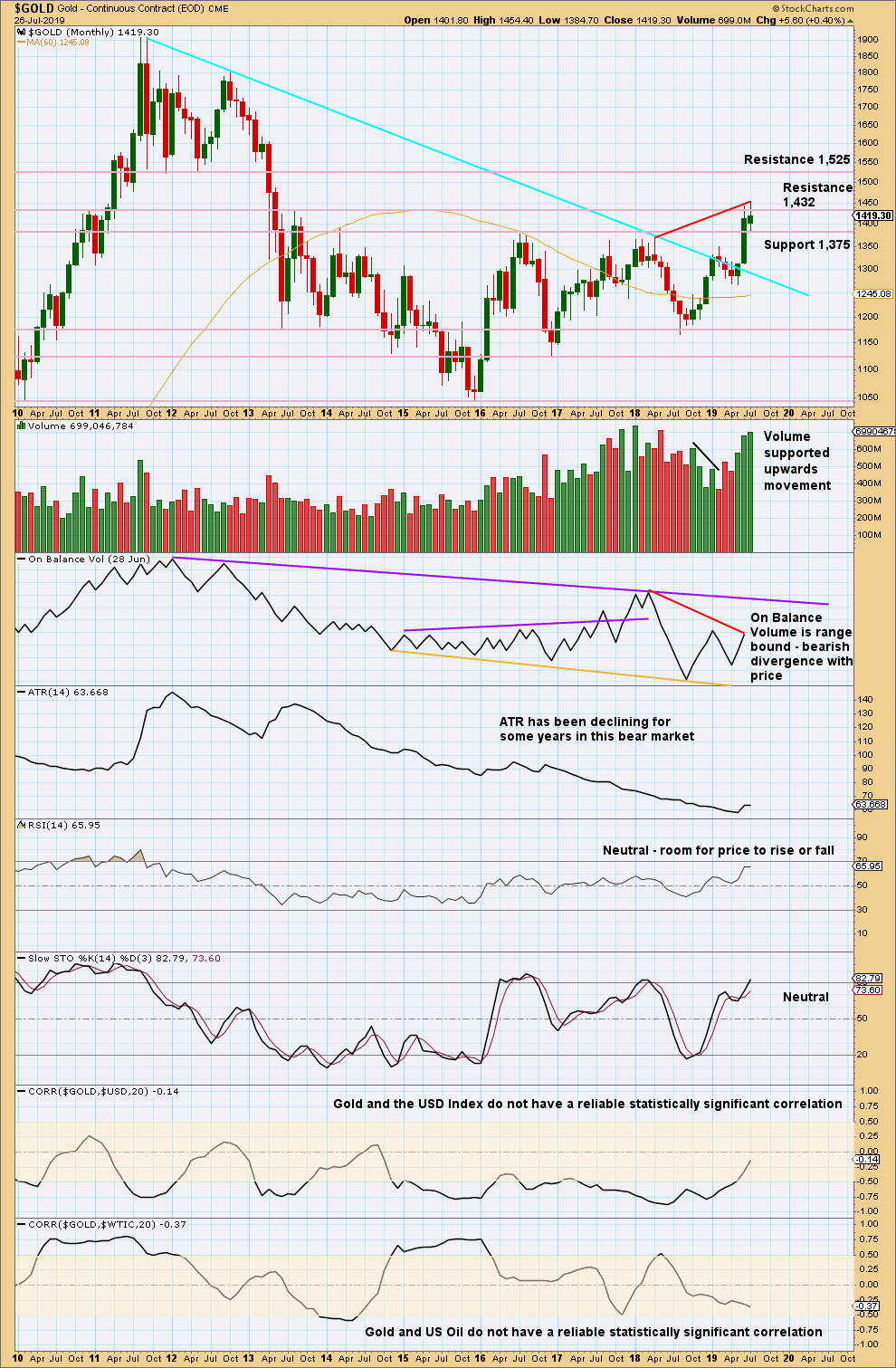
Click chart to enlarge. Chart courtesy of StockCharts.com.
Gold has effected an upwards breakout above multi-year resistance and above the cyan bear market trend line. Look for next resistance identified on the chart.
The new high in price above prior highs for March / April 2018 have not been matched by new highs for On Balance Volume. This divergence is bearish and supports a bearish Elliott wave count. This divergence may be given a little weight because it is strong and evident on the monthly chart.
WEEKLY CHART
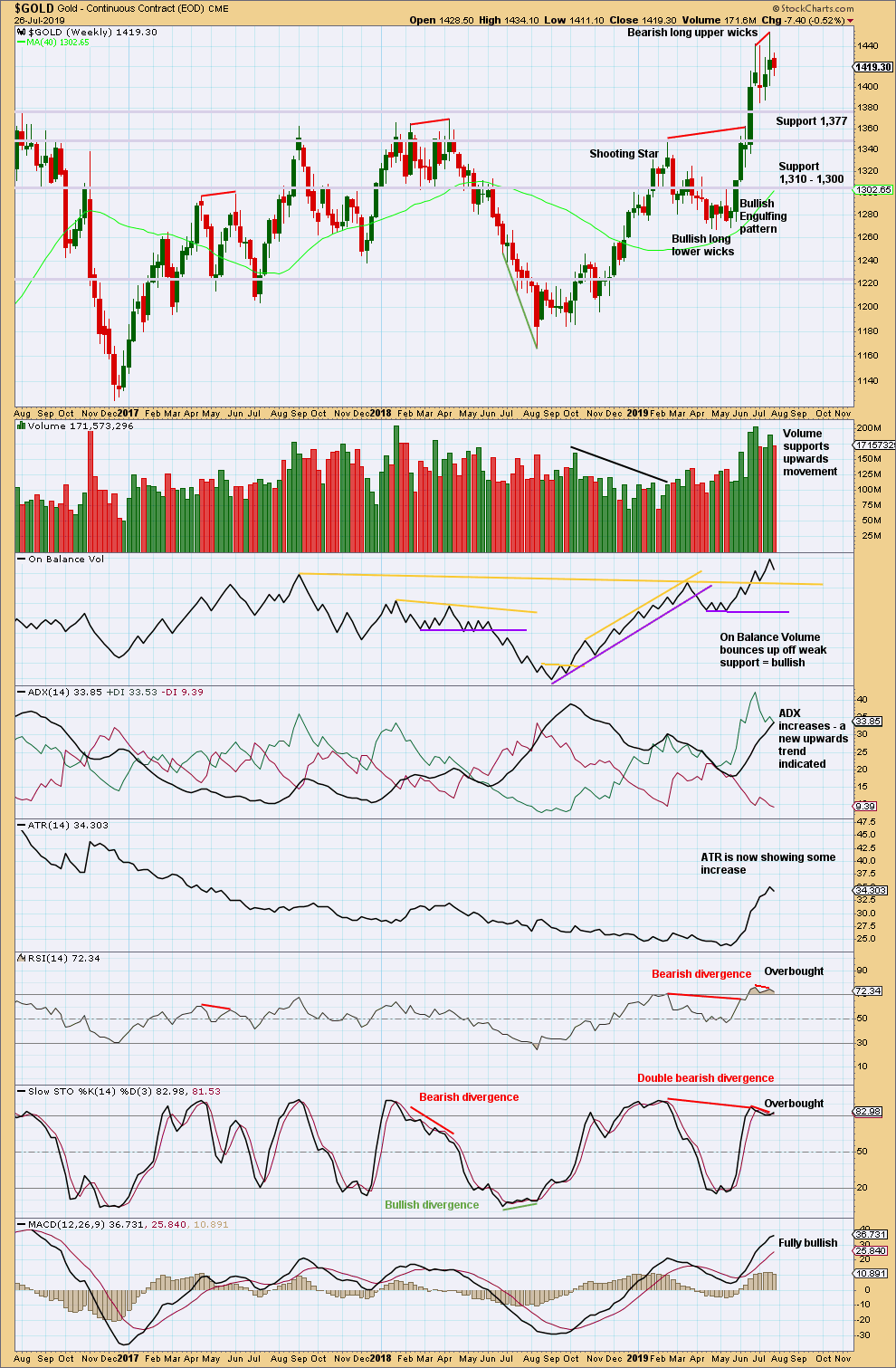
Click chart to enlarge. Chart courtesy of StockCharts.com.
A new high two weeks ago exhibits some bearish divergence between price and RSI. However, as has been seen recently, sometimes this divergence simply disappears.
The bottom line remains that a multi year breakout occurred a few weeks ago, and it occurred with strength in volume. While price remains above support about 1,377 and ADX indicates an upwards trend, this chart will remain overall bullish.
DAILY CHART

Click chart to enlarge. Chart courtesy of StockCharts.com.
A slow drift lower with declining ATR this week looks like a counter trend movement to relieve extreme conditions.
Extreme conditions for ADX have not yet been relieved. The ADX line remains above both directional lines and still close to 40.
RSI is now back in neutral territory.
Another week or so of consolidation or pullback may be required to complete before the larger upwards trend is ready to resume.
GDX WEEKLY CHART
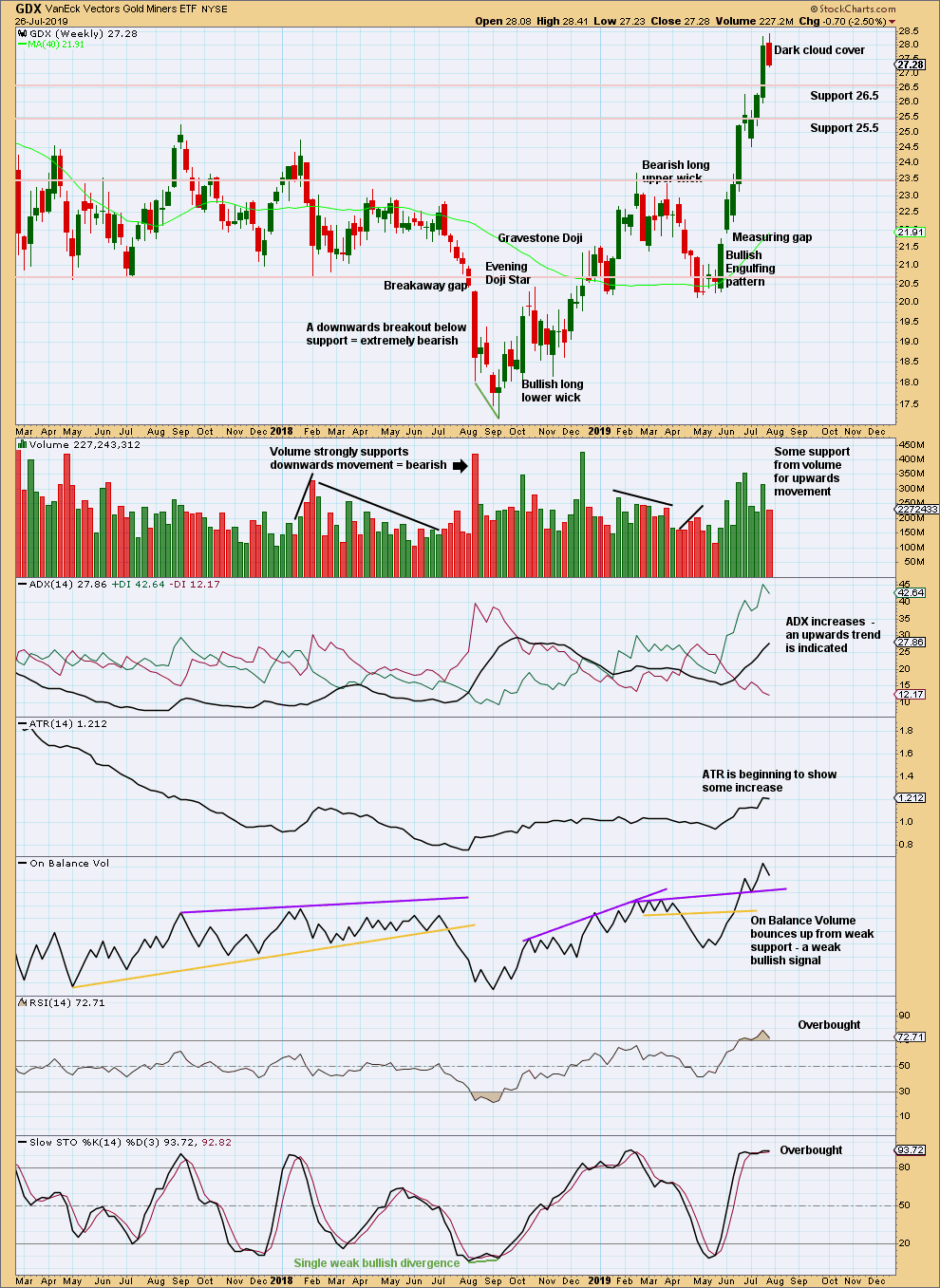
Click chart to enlarge. Chart courtesy of StockCharts.com.
The bearish candlestick reversal pattern this week indicates a potential trend change.
Candlestick reversal patterns make no comment on the direction of the new trend (a full 180 degree reversal or sideways) nor for how long it may last. This reversal pattern may indicate a consolidation to unfold here, or it may indicate a new downwards trend.
Strength or weakness in the next one to very few weeks may indicate which scenario may be preferred.
GDX DAILY CHART
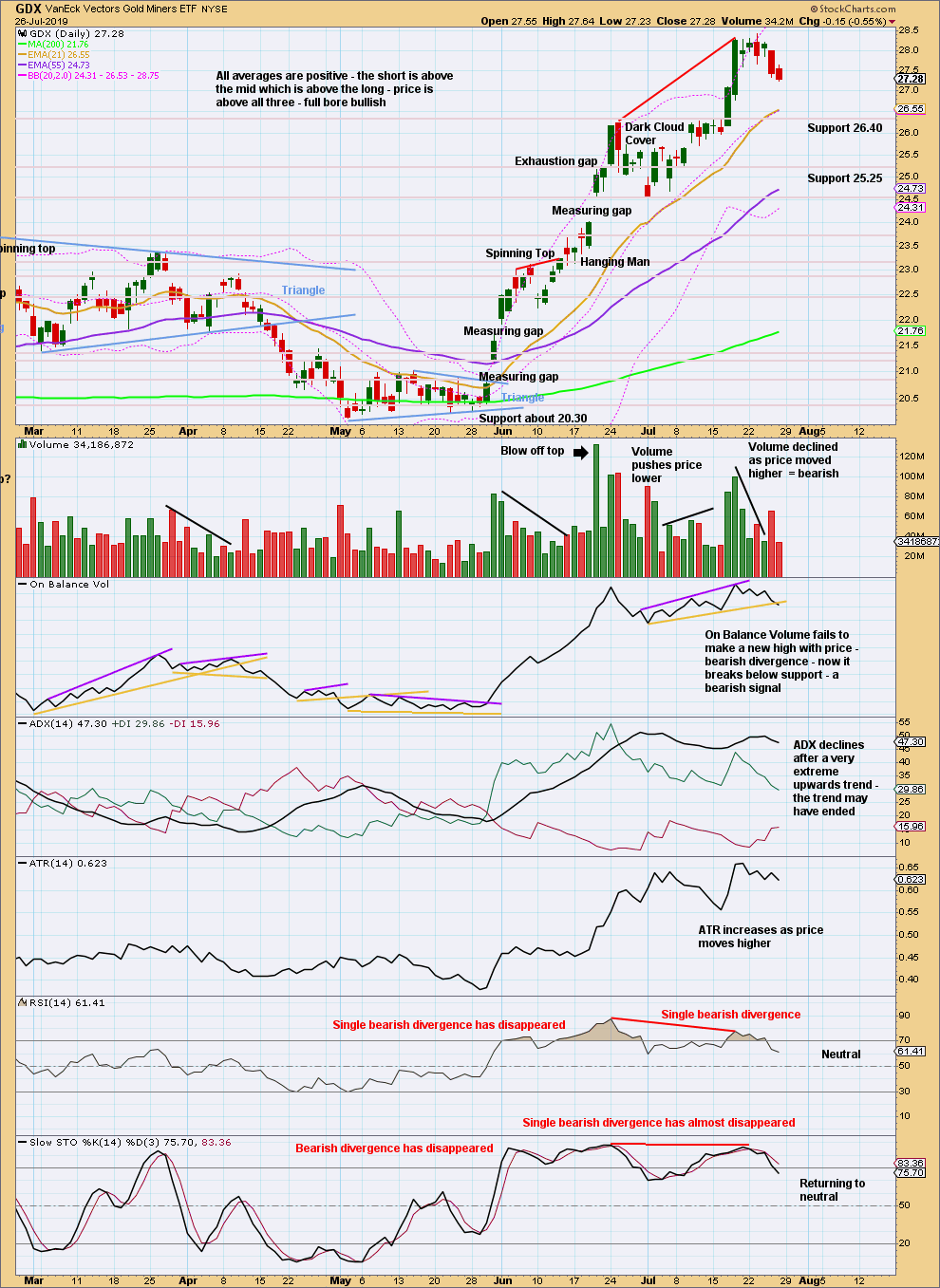
Click chart to enlarge. Chart courtesy of StockCharts.com.
The short-term volume profile and a bearish signal now from On Balance Volume support a bearish outlook for GDX at least for the short term.
A new swing low below 24.53 would confirm a trend change.
Published @ 01:34 a.m. EST on July 27, 2019.
—
Careful risk management protects your trading account(s).
Follow my two Golden Rules:
1. Always trade with stops.
2. Risk only 1-5% of equity on any one trade.
—
New updates to this analysis are in bold.

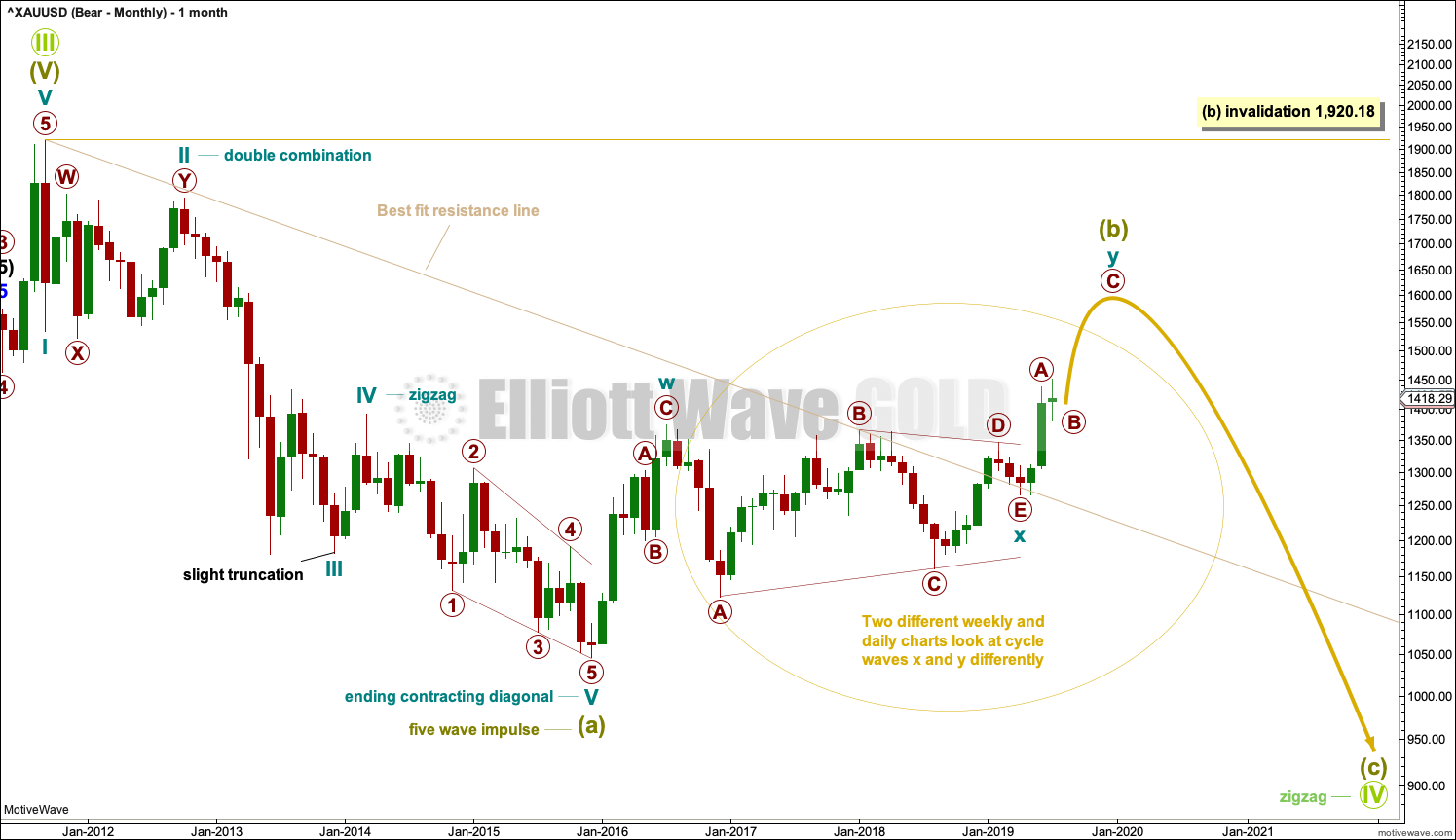

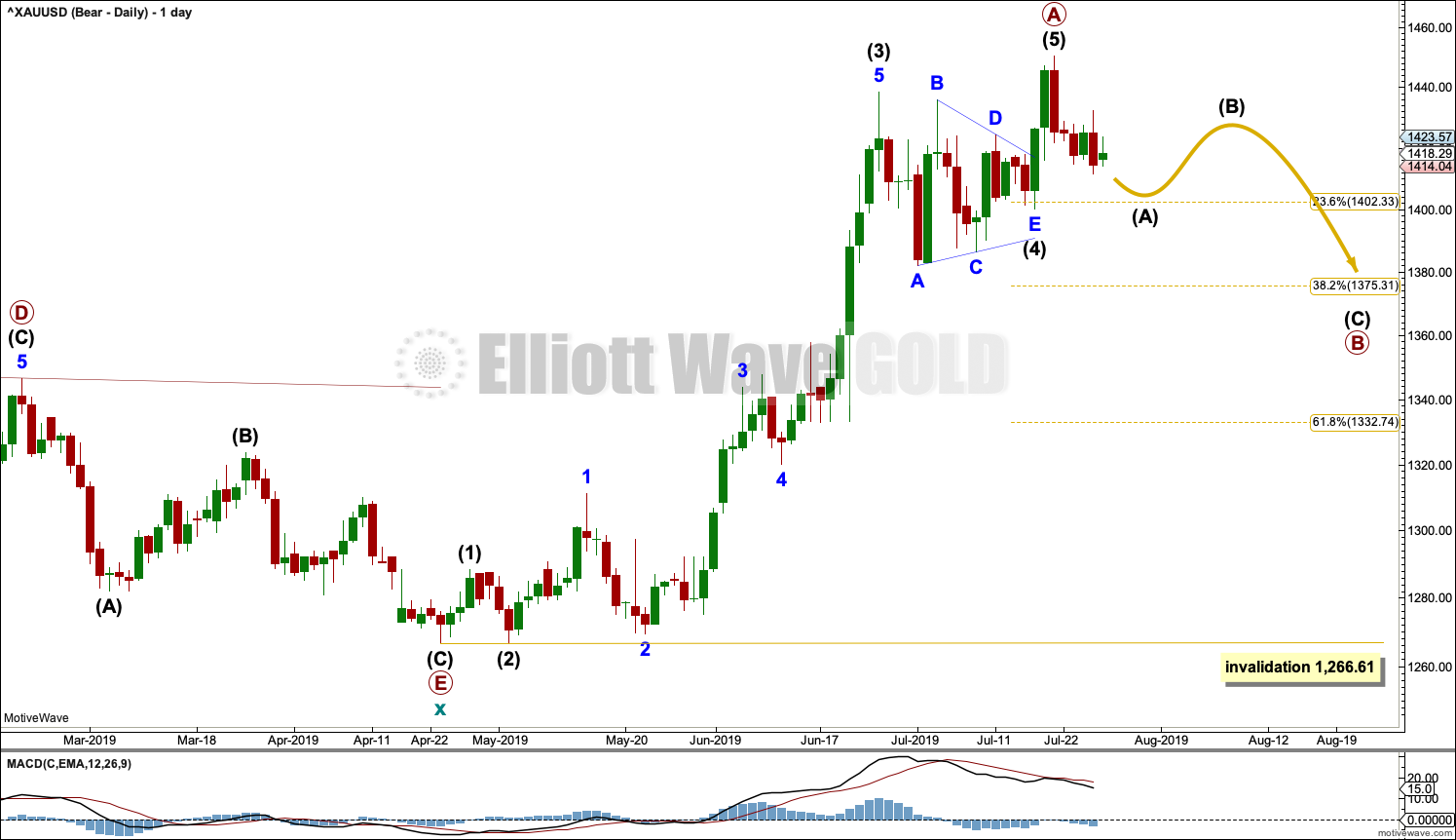
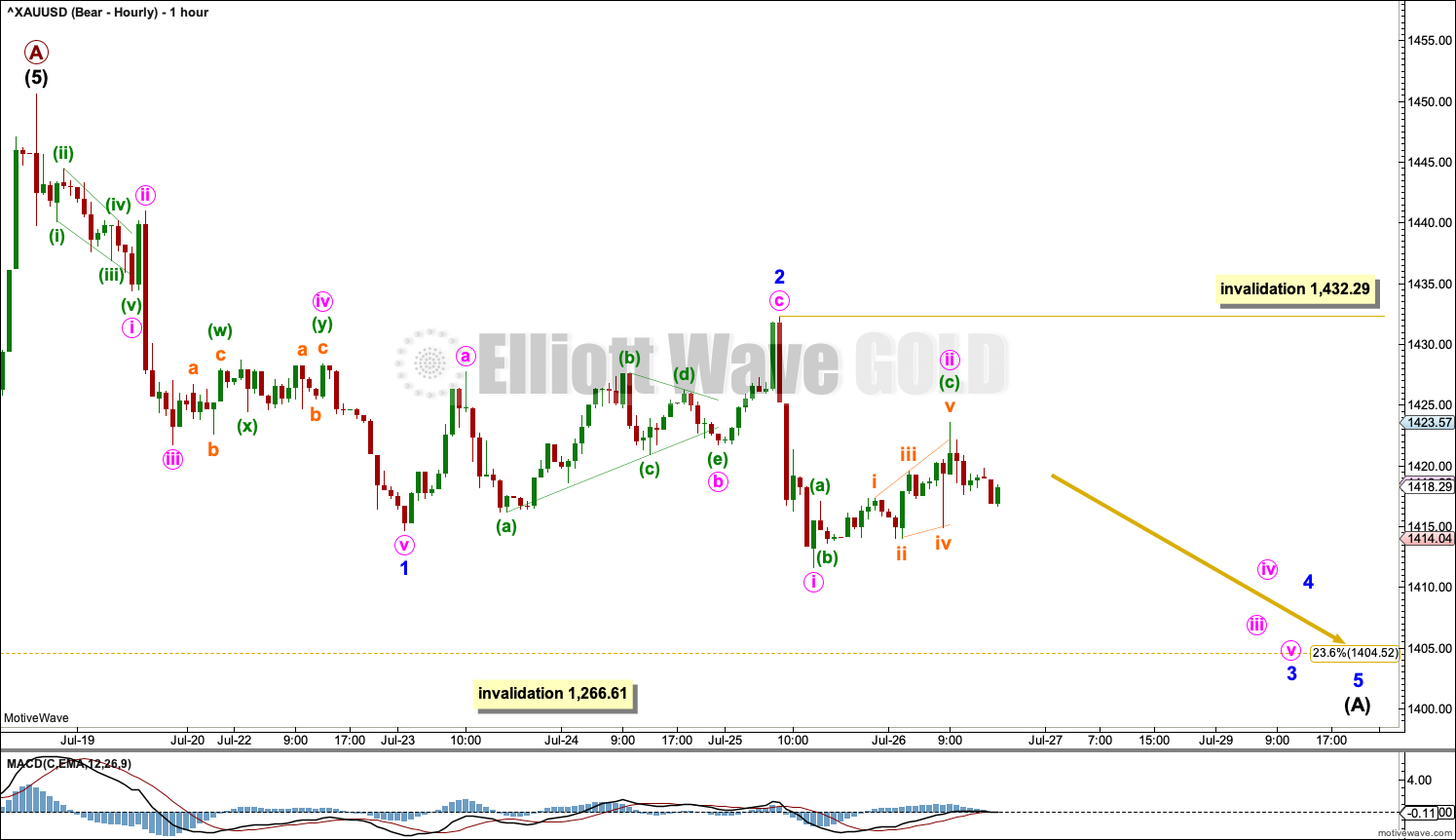
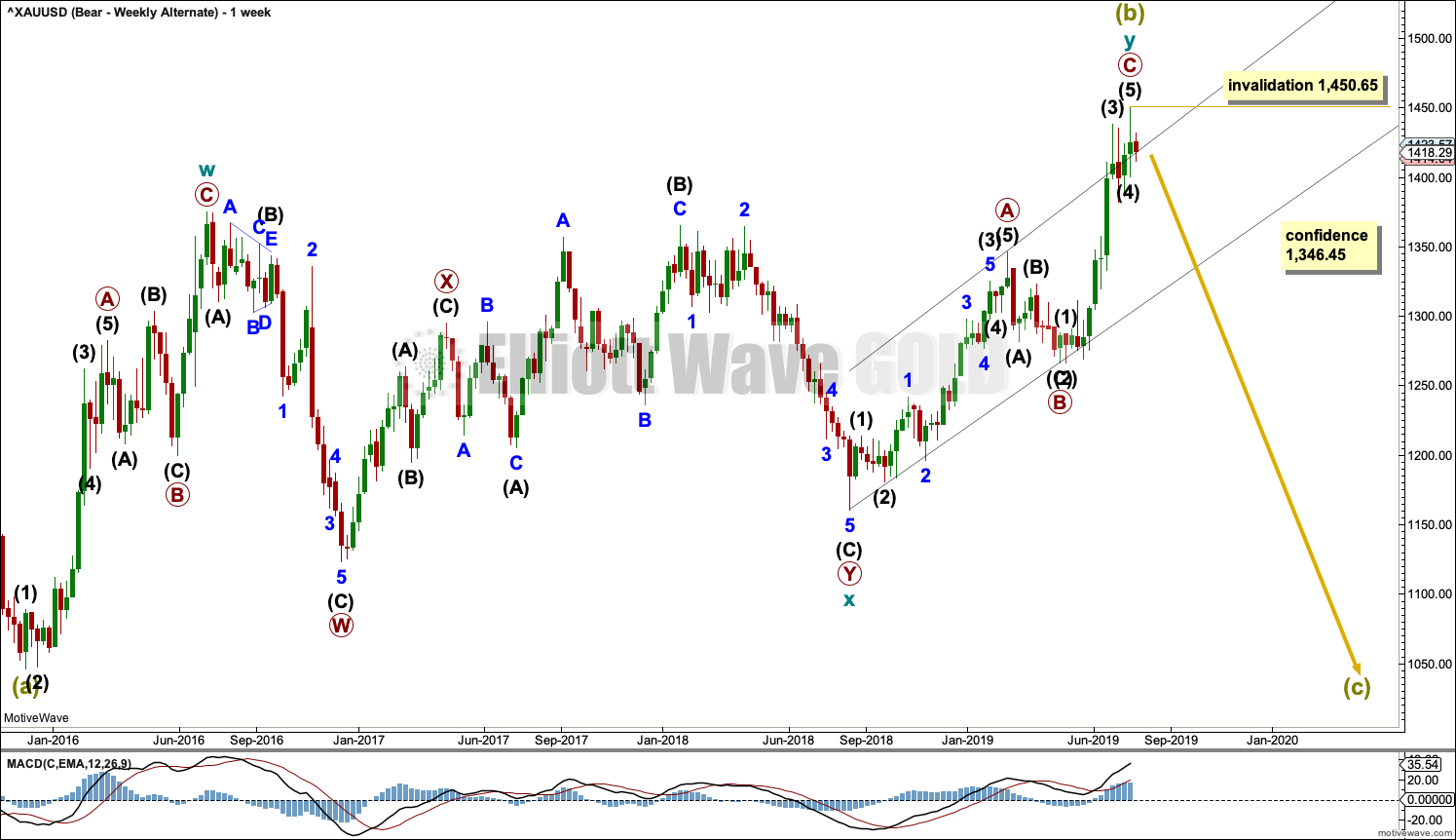
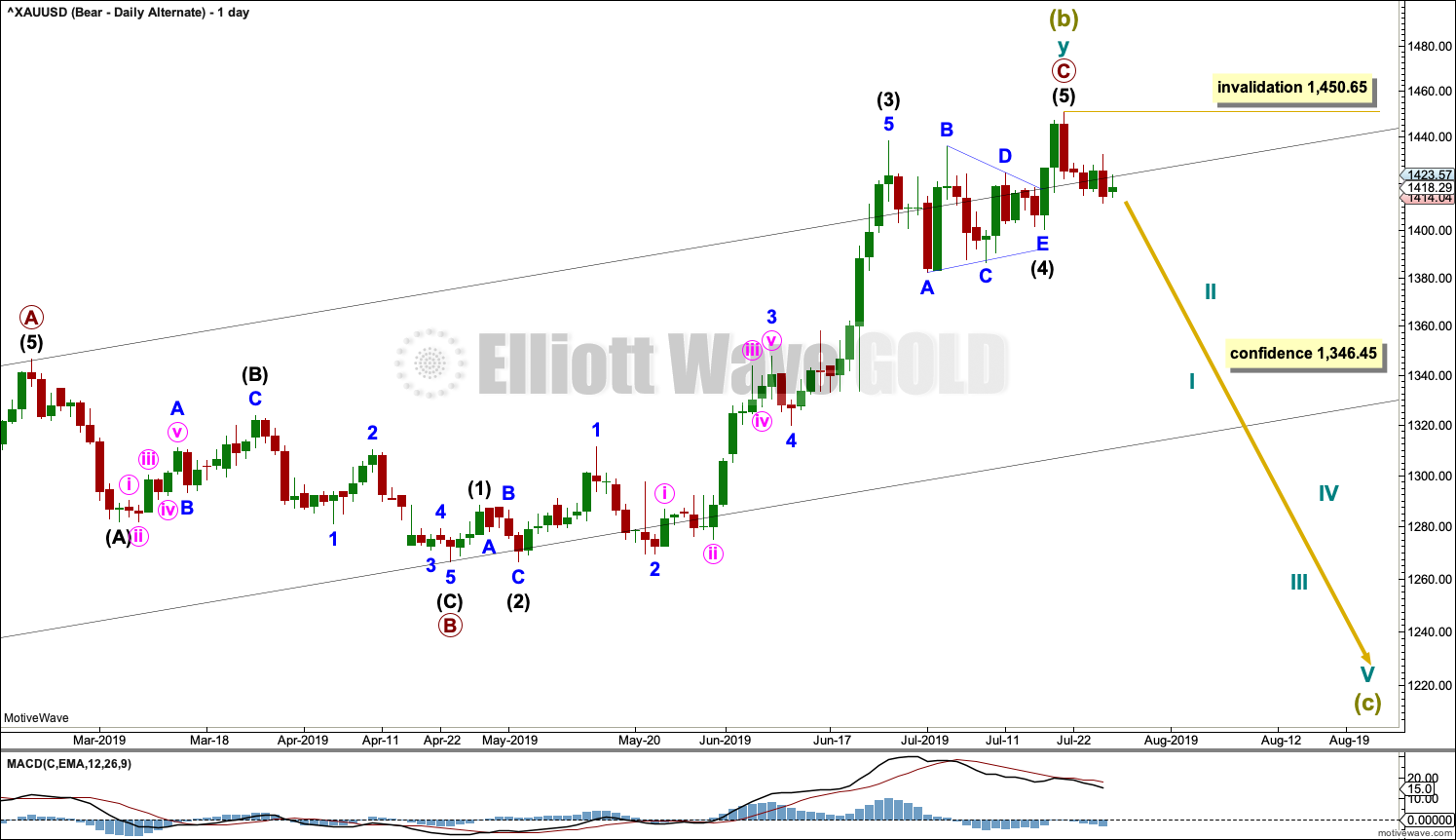

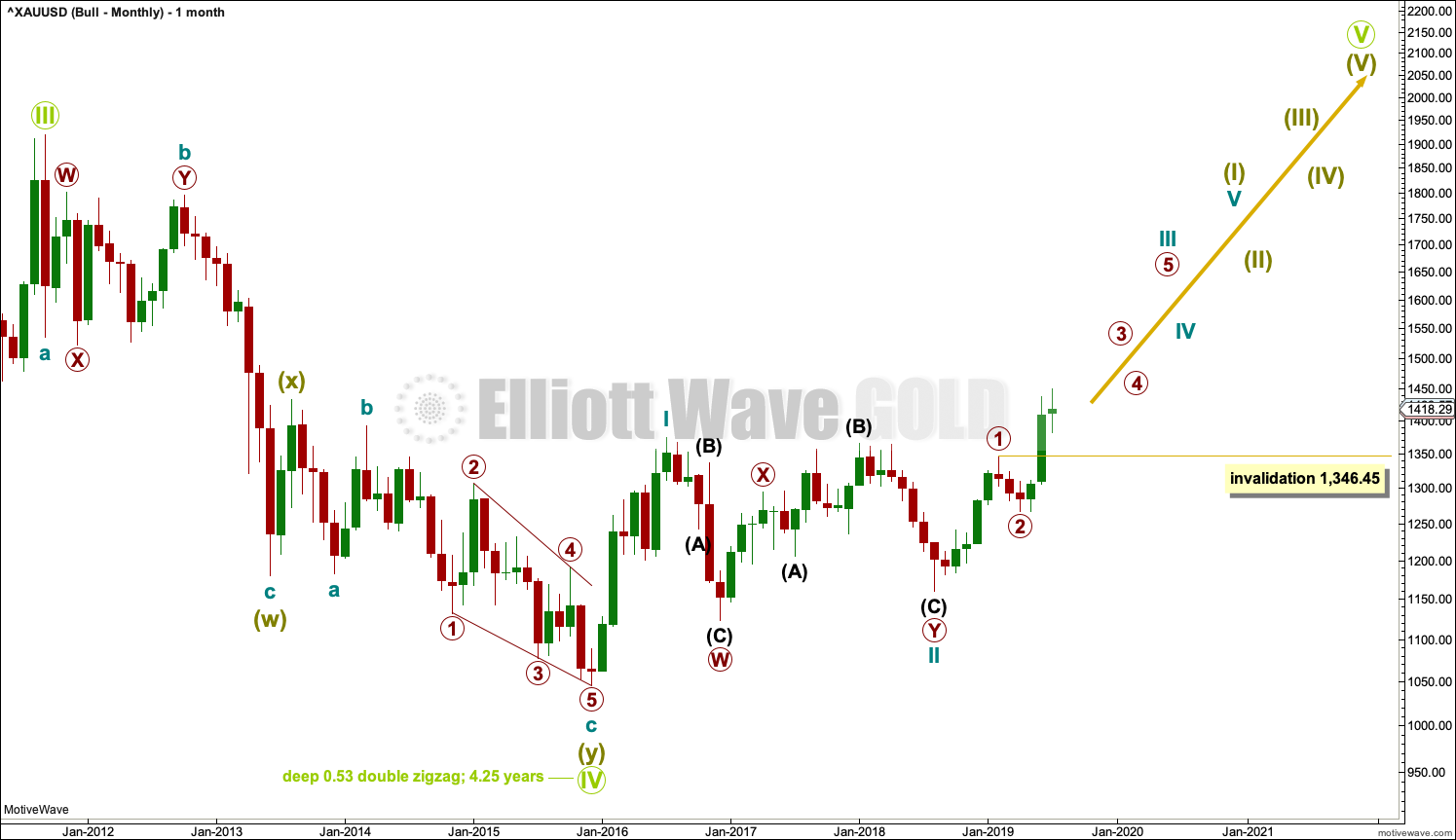

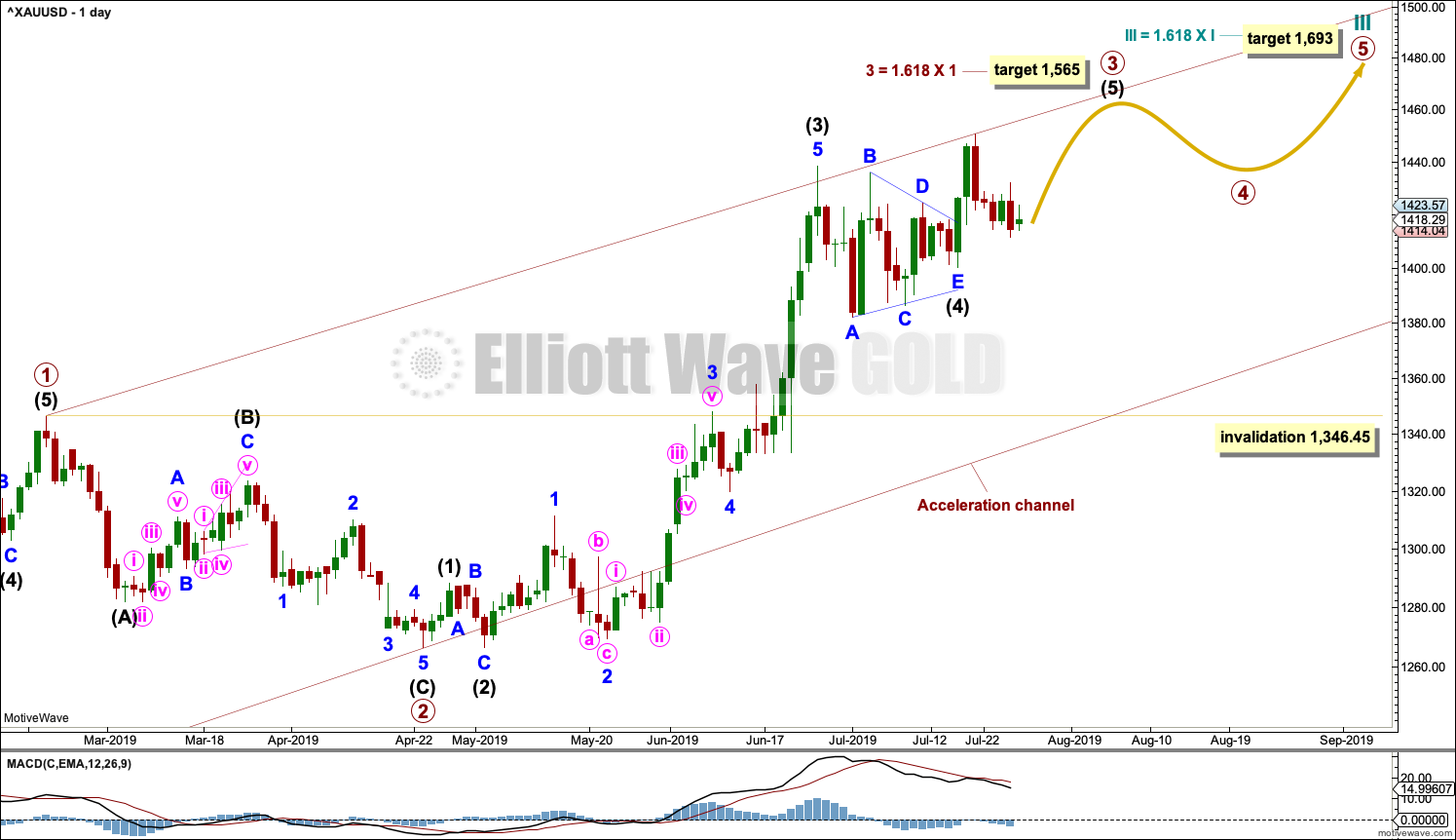
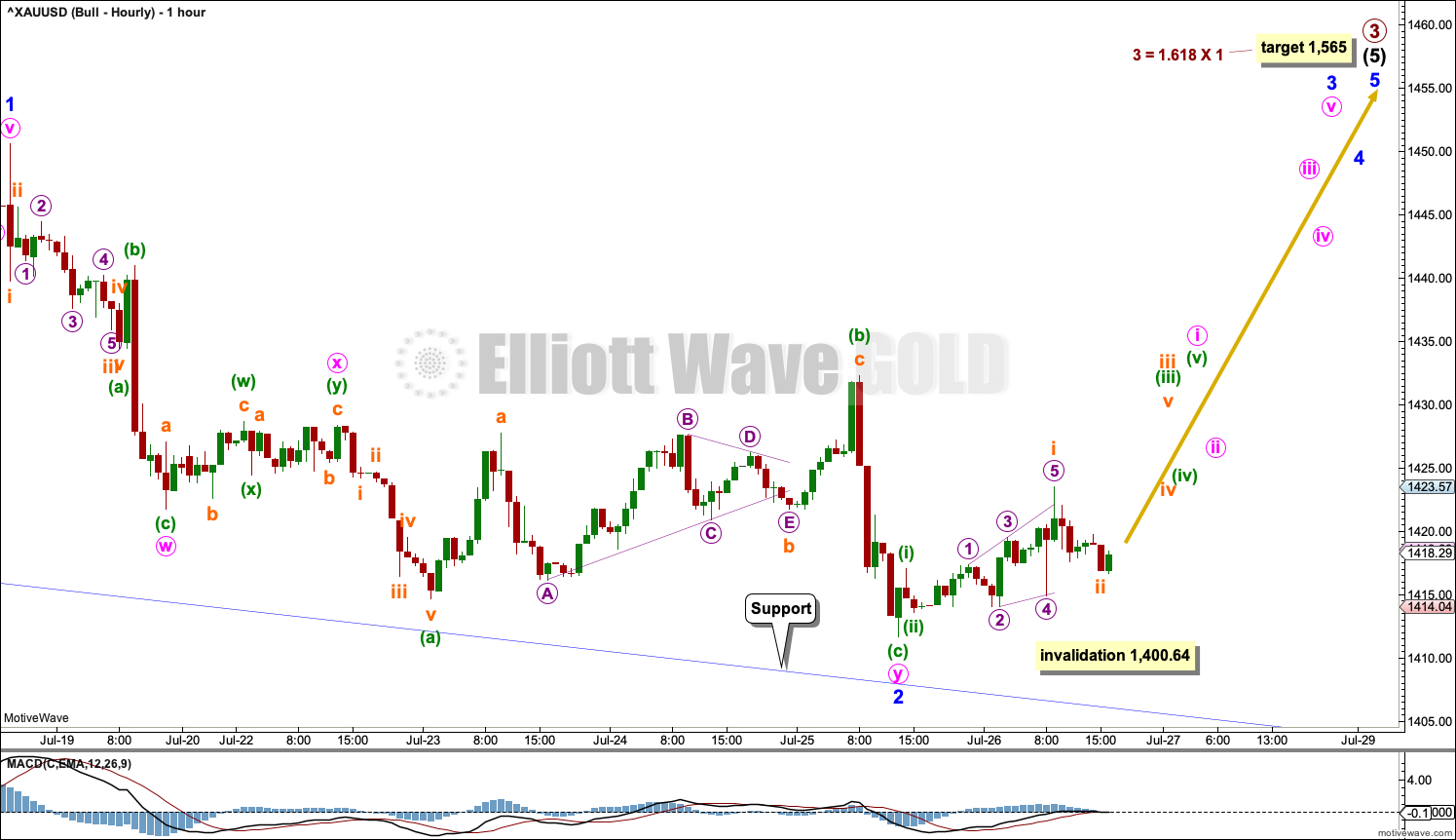
Hi,
some data provider issue?
I’ve checked few brokers and everyone shows this spike candle at first hour of trading in NY.
(unfortunately have some problems with attaching a print screen).
Rgds
Mat
Hourly bear chart updated:
I’m moving the invalidation point back to the high to allow minor 2 to continue higher to better reach the 0.618 Fibonacci ratio. It may do so as an expanded flat.
Hourly bull update:
Lara,
I think you have the wrong chart here! it is SPX not gold!?
Woops. Not that I mind, but this is for the S&P.
So since its here, are you predicting any bear trend in that or only bull?
Lara, thanks for the Monthly Charts. I also like that you have chosen the Y=W count as your main count. 🤩 1,595 is like a magnet 🧲
Add to Historical?
You’re welcome.
I did remember to add it to historical… then I forgot. One day I will remember that detail without you having to remind me! ☺️